 Your usual server won't be with you tonight. She's come down with a small case of murder. 
The Swinging Barmaids, which splashed across U.S. screens for the first time this month in 1975, is one of those movies with a deliberately misleading title. Rather than the breezy erotic romp you'd expect, it's a thriller about an insane serial killer who stalks a group of waitresses working in a Los Angeles go-go bar. The problems commence when Dyanne Thorne (yes, she made movies aside from the Ilsa atrocities) is stabbed to death, setting off an inept police investigation, while the killer sets his crazy sights on more victims. He's the classic maladjusted loner you find in ’70s grindhouse filcks. You know the type: “You're the first girl I ever met that wasn't dirty underneath.” What type of woman wouldn't immediately leave town after hearing something like that? Answer: a woman in a bad movie. Eventually, to facilitate his homicidal efforts, Mr. Maladjustment gets a job as a dishwasher at the bar. More killings eventually lead to the unveiling of this wolf in the fold, and his inevitable perforation with 12-gauge buckshot. That isn't a spoiler. His death is the entire point of the film. Well, that and boobs. But the problem is that this is all mounted perfunctorily, is poorly written, visually lackluster, narratively sluggish, and devoid of actorly charisma. In fact, if not for the nudity, you'd think The Swinging Barmaids was a minor television movie. The best thing going for it is the above poster art by the incomparable John Solie. Check, please.
        
 Gordon and others get bushwacked in no-budget horse opera. 
L'éperon brûlant is a U.S. movie titled Hot Spur, but once again we found a foreign poster far more intriguing than the domestic version. The movie was originally released in 1968, but this poster is from France and was made for the movie's preimier there today in 1970. It's signed by the artist: Loris. We can't tell you anything about him or her except that they also painted posters for 1971's L’homme qui vient de la nuit and 1974's La virée superbe. This is an interesting effort.
We mainly wanted to watch this for raven brunette beauty Virginia Gordon, so imagine our suprise and dismay to see the filmmakers turn her into an unnatural blonde. In any case, the movie is nothing special—it's a Western revenge drama, poorly directed by Lee Frost of Policewomen fame, and poorly acted by Gordon and everyone else. Basically, a Mexican farmhand is driven by constant abuse to seek revenge, and does so by kidnapping his cruel employer's wife. Probably a bad idea.
The film takes advantage of the fraying censorship enforcement of the era to show more nudity and sexual violence than in previous years. There are themes embedded within the script about racism, patriarchal control, and what we'd call today male toxicity, but they're so obscured by sexploitative content that you'll be too busy feeling queasy to absorb any well-intentioned messaging. L'éperon brûlant/Hot Spur is basically a footnote suitable for true cineastes only. All others can give it a pass.
We decided to share this specific poster for a secondary reason. Users on both Alamy and Diomedia claim it as theirs, which is what happens when bloggers and Ebay sellers post high resolution images online to be hoovered up by opportunistic hustlers. Not that we don't sometimes get images from Ebay. This one came from there. But we don't try to claim false copyright on them. Once upon a time we considered uploading our thousands of original scans at huge sizes, but now the decision not to looks pretty smart. Many of those images would be on Alamy, Shutterstock, et al now.
In the last several years the problem of copyright squatters has grown, and with AI programs scouring the internet for instances of presumed infringement, threatening e-mails are increasingly going out to website operators. But once again, it needs to be pointed out that movie posters and promo shots were made for non-copyright holders to publicize the associated works, and such items fall into the category of fair use. The copyright on this poster belongs to the film studio or production company that originally made it (Les Films Leitienne), and isn't transferred just because someone uploaded it to Alamy or any other site. If you operate a blog and get a threatening e-mail, ask for documentation of copyright. They're obligated to provide that. But they won't be able to.     
 Do not centerfold, spindle, or mutilate. 
The Centerfold Girls has a pretty anodyne poster for what is a decidedly provocative film. It hit cinemas today in 1974 and is about a religious fanatic played by Andrew Prine who wishes to save (read: murder) three women who've posed nude for a men's magazine called Bachelor. The film is divided into chapters, with the story around each stalking target—Jaime Lyn Bauer, Jennifer Ashley, and Tiffany Bolling—given about one third of the running time. Obviously that means—er, sorry, strongly suggests—that at least two of the trio die. Spoiler alert! There could also be collateral damage. Spoiler... allusion?
The movie lacks the tongue-in-cheek aspect of so much sexploitation cinema, falling more into the category of in-your-face grindhouse efforts like Thriller - en grym film and I Spit on Your Grave. In other words, it's a mean little movie. But one with serious intent. There's real effort made at character development, for example Ray Danton's feckless playboy in chapter two. There's also effort made to make the film look good. It's cheap but competent, with some Hitchcockian touches added by experienced television and b-movie director John Peyser meant to let cinephiles know he's no hack.
We came across comments in several places saying the movie is disrespectful toward women. That's true. Any film that casts any distinct category of human as victims (and in grindhouse it's usually women) can automatically be seen by some as targeted oppression—especially when that oppression is rampant in the real world. No film called The Centerfold Girls is interested in avoiding that criticism, so you go in knowing that. The result? It's pretty good. You know what would have been really fun? If they'd made a sequel called The Centerfold Boys about Playgirl models. Beautiful, superficial, basically helpless male models. We should have been 1970s movie producers.                
 Nygren and friends teach moviegoers all about natural selection. 
We'll return to paperback covers tomorrow, but for the moment we're running with the same sort of material we posted a couple of days ago, because as the weather warms thoughts naturally turn to sensual pleasures. We can't think of a movie more sensual than Emmanuelle IV. Set in our planet's most sensual country, steamy Brazil, it was the entry in the Emmanuelle series that ushered original lead Sylvia Kristel out the studio gate, and brought in the first of several new Emmanuelles, in this case Swedish actress Mia Nygren. This West German poster, on which the film is titled Die orgien der Emmanuelle, or “the orgies of Emmanuelle,” caught our eye because—well, for several reasons—but mainly because Nygren is pushed into the background by Camella Donner, aka Camella Thomas. Why is that so interesting? Because she isn't in the cast. She probably wasn't even on the same continent. We guess the West German distributors wanted to sex up the poster a bit more. Donner would have been a great addition to the film, but even without her it was fun. Ridiculous, stupid, carnivalesque fun. They don't make 'em like that anymore. Emmanuelle IV premiered in West Germany today in 1984. Bonus imagery below.
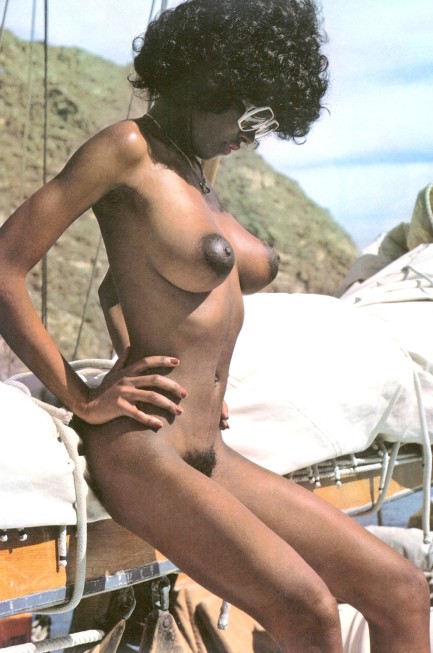 
 It's the same old story. Take a trip to the tropics, lose every bit of self control. 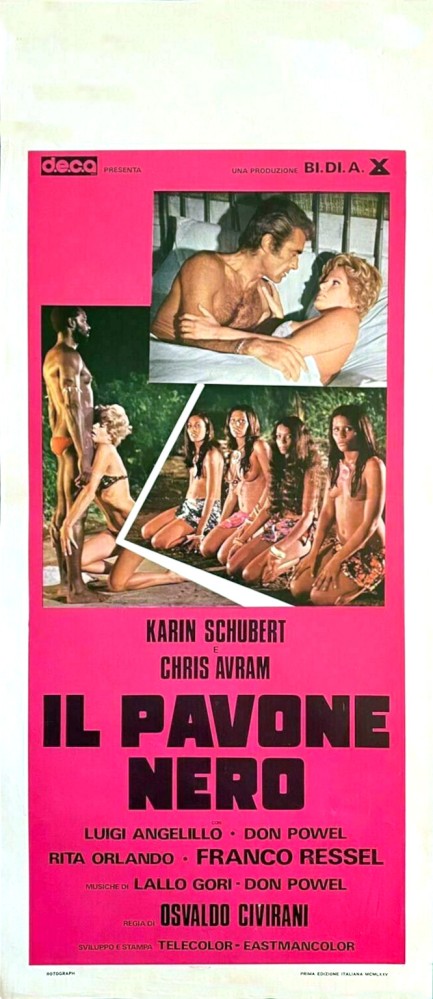
We ran across this Italian locandina for the shot-in-the-Dominican Republic sexploitation flick Il pavone nero, known in English as Voodoo Sexy, and thought it made a nice alternate promo to the one we posted years back. The movie premiered in Italy today in 1975, and with a title like Voodoo Sexy you know what it's about: white skin + tropical heat = a total loss of inhibitions. Flicks of this ilk were an unofficial subgenre of ’70s and ’80s cinema. We love them, and you know why? Because they aren't wildly inaccurate in terms of northerners going crazy down south. The star of this one was German actress Karin Schubert, and that's the other reason we revisited the film—it gave us an excuse to share the photo of her below. Hope it helps you get over hump day. 
 In the land of the blind the one-eyed woman is queen. 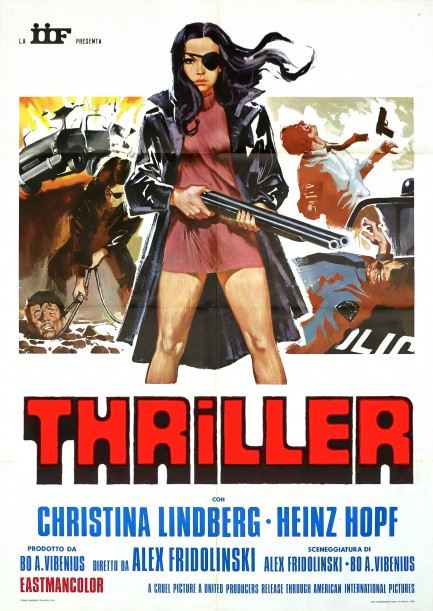 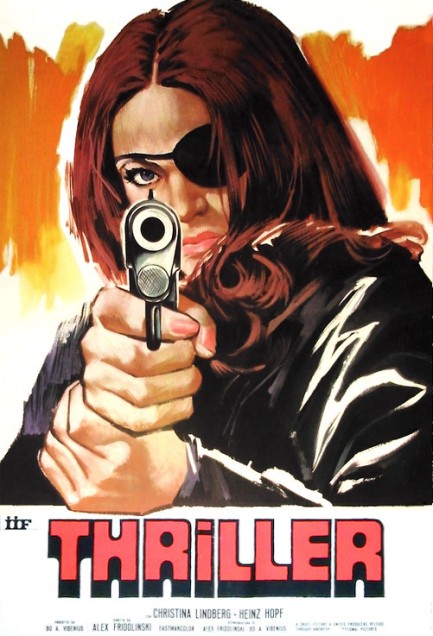 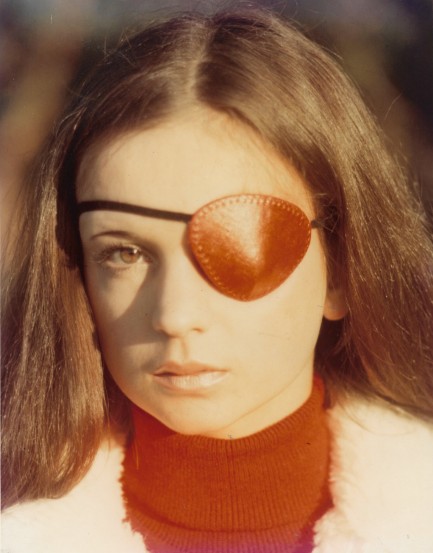
We've done a lot on Sandro Symeoni, which means that just for the sake of completeness we can't overlook these. They're his Italian posters for the Christina Lindberg grindhouse classic Thriller, which was originally made in Sweden as Thriller - en grym film, and in English speaking countries was known as Thriller: A Cruel Picture and They Call Her One Eye. We've already talked about it, and its star.
 In Japan business is war—complete with innocent bystanders. 
This brilliant promo was painted for Hana to hebi: Shiiku-hen, known in English as Flower and Snake 3: Punishment. It starred Minako Ogawa of Dan Oniroku ikenie shimai, aka Sisters To Be Sacrificed, and in fact the same painter must have produced both posters. Have a look. The central figure is almost identical, no? Right down to her hairy armpits. Since there's no official info on who the artist is we'll throw in our two cents. It was bondage painter Kaname Ozuma. He painted at least one other poster for the Flower and Snake series, which you can see here. In the meantime this piece is literally nowhere else to be found in the quality you see here. At least, as far as we can tell.
We watched the film and it's a typically perverse roman porno tale about a powerful businessman married to Minako Ogawa, who he stole from a subordinate who was helpless to prevent it. When he later declines to help a business associate out of a jam that person has Ogawa kidnapped—literally thrown into a giant bag—taken to an isolated house, sexually assaulted, and coercively trained using bondage, a kielbasa, and other esoterica in order to turn her into a performer for live sex shows. That's a hell of a twisted retaliation for being refused financial help, but twisted is what roman porno is all about.
Of technical note is the fact that, though it was illegal to show pubic hair in Japanese movies, the ever clever roman porno filmmakers found a loophole. They have Ogawa's captors, as part of her torment, cut off her pubic hair with scissors. Though it couldn't be shown attached to her body without bringing down the wrath of censors, they got away with showing it falling into bathwater. You gotta give the pervs credit. They were always thinking outside the—er—box. Hana to hebi: Shiiku-hen premiered in Japan today in 1986.
After a long day on the set filming sex and bondage... I'm very happy to spend the evening doing this.

 Their grades aren't great but their extracurriculars are incomparable. 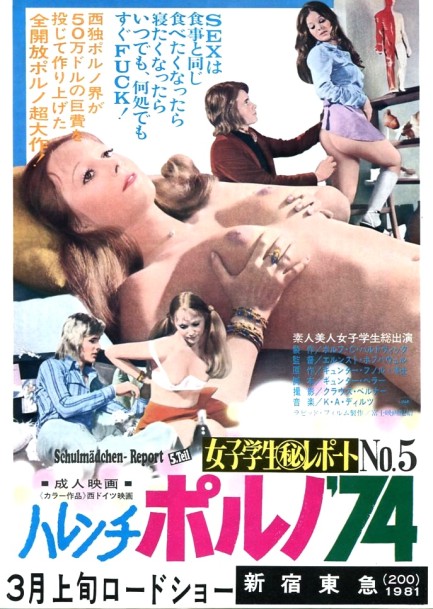 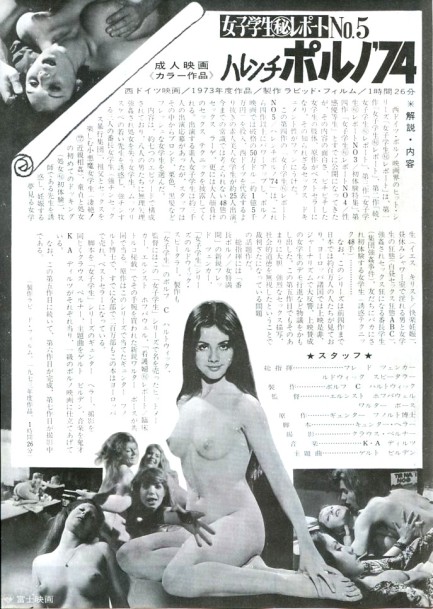
Two years ago we shared a brilliant Japanese poster for Schulmädchen-Report 5. Teil - Was Eltern wirklich wissen sollten, aka Schoolgirl Report Part 5: What All Parents Should Know. Above you see an alternate poster, front and back. It's a strange movie, part of a series of thirteen, which you can read about here.
 Caffaro knows how to Handle her business. 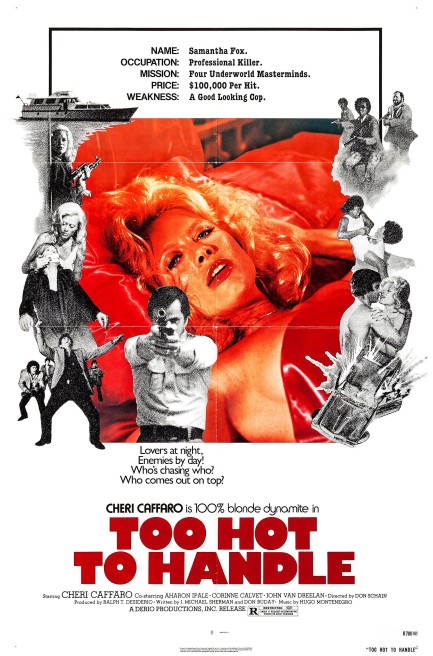
Why do we spend our valuable time watching exploitation movies? Well, because we watch all pulp related genres of movies, from film noir to horror. So why discriminate? We also watch such movies (which is a set we figure includes sexploitation, blaxploitation, women-in-prison, and more) because owing to their sexual, racial, and political aspects, their like will probably never be made again. Last month we completed our look at Cheri Caffaro's infamous Ginger McAllister sexploitation-spy trilogy. Now we're moving on to her later work in Too Hot To Handle, which premiered today in 1977.
Set in and around Manila, Caffaro plays an experienced and wealthy assassin named Samantha Fox who takes on a difficult triple-contract. In order to succeed she'll need all her skills of disguise, deception, and sexuality. Meanwhile the cops are on her trail. When one of the investigators gets close—real close—Caffaro takes a liking to him and, passing herself off as her alter ego Melinda Burroughs, tries to navigate sleeping with the enemy while fulfilling her murderous obligations.
All Caffaro movies are low budget, and all are bad. This one is poorly written and acted, and as usual there's a touch of the kinky, both in front of the camera, as well as behind, as Caffaro's husband Don Schain directs her getting her squeezebox fondled by hairy co-star Aharon Ipalé. That's called commitment to the product and your art—or alternatively, finding a way to monetize your spouse-sharing fantasies. It didn't improve the movie.
The only surprise here was that former top European star Corinne Calvet somehow got suckered into playing a brothel owner named Madame Ruanda, later dying as one of Caffaro's targets. Alas, Corinne—sexploitation is a welcoming mistress for those desperate to pay bills, but next time we recommend a loan shark. The vig is a bitch but at least you get to hang onto your dignity. But even if Too Hot To Handle was too bad for Calvet to be in, it isn't too bad for you to watch. Caffaro is weirdly great. In the sexploitation realm nobody did more with less.
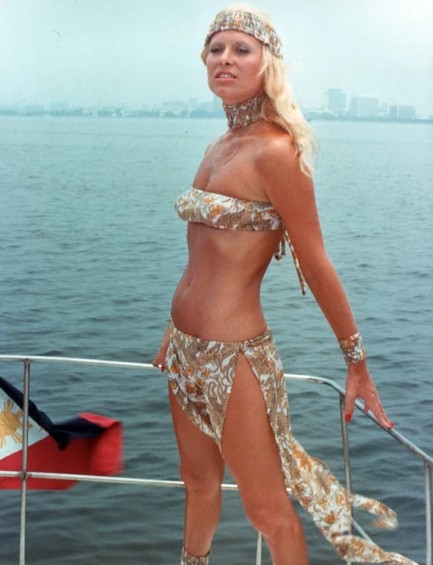 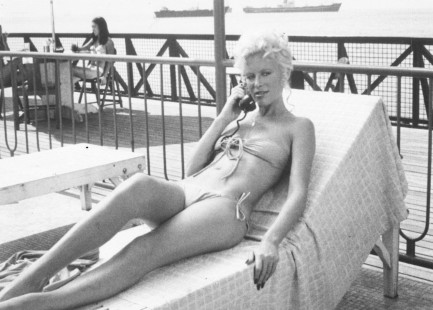 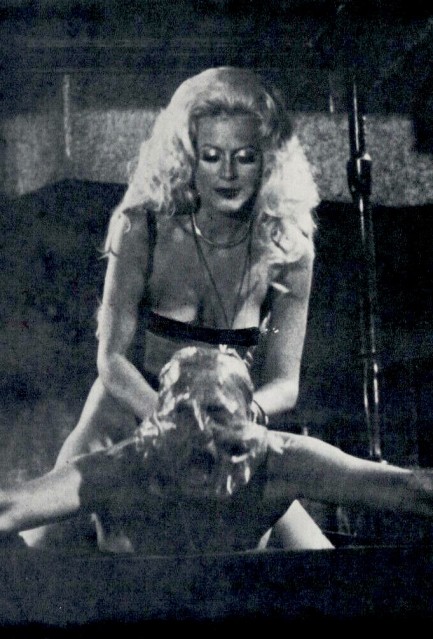 
 The lawless of the jungle. 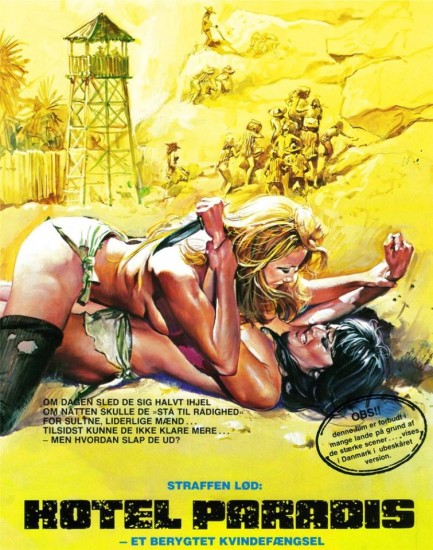
The curious and certainly never-to-reappear style of movies referred today as women-in-prison, or WIP, is a subgenre of sexploitation cinema that came about for one reason: it used settings in which women were helpless. Well, in theory. The dramatic thrust of the plots always derived from attempts to retain dignity and to escape captivity. The protagonist was usually an odd woman out—an unjustly imprisoned victim or an undercover operative—surrounded by a mix of prisoners who were hopeless, cruel, sexually predatory, and complicit, plus the abusive guards, one of whom nearly always was a sadistic woman.
Hotel Paradis stars Anthony Steffen, Ajita Wilson, and the slinky Cristina Lay, sometimes referred to as Cristina Lai. There are numerous posters for it, but we like the above Danish effort featuring a fight to the death. Its text notes: This film is banned in many countries because of its strong scenes.... it's shown in Denmark in uncut version. Indeed. Interracial lesbian sex might be to blame for the banning. There are other possible reasons too. We won't waste our time trying to figure it out. As an aside, the movie was filmed concurrently with the WIP flick Femmine infernali using the same cast, director, and sets. So consider this a write-up of that movie too, since the pair are basically identical.
Plotwise, a group of women are being transported to a jungle hellhole prison where forced labor is used to dig for emeralds. When their guards are ambushed and killed by patriot soldiers seeking to steal the emeralds to fund a nebulous revolt, the women agree to continue posing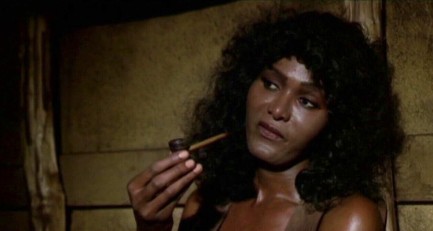  as prisoners in order to aid the infiltration of the camp. Behind bars is one inmate—Wilson—who has the shining or something, and keeps telling the others that violence, death, and freedom are coming. Also coming are WIP staples such as the evil wardenness, languorous shower scenes, whippings, baroque tortures, and sexual assault. It all ends pro forma with a climactic shootout. as prisoners in order to aid the infiltration of the camp. Behind bars is one inmate—Wilson—who has the shining or something, and keeps telling the others that violence, death, and freedom are coming. Also coming are WIP staples such as the evil wardenness, languorous shower scenes, whippings, baroque tortures, and sexual assault. It all ends pro forma with a climactic shootout.
Obviously, you have to go into these types of movies with a sense of humor if you can. When Lay first meets Wilson in the camp, she says, “My name's Maria. I'm frightened.” Why, oh why, didn't Wilson respond, “I'm Ajita. I'm a virgo”? Too bad we didn't write the script. Lay then helps herself to Wilson's pipe—which Wilson just a bit earlier had used to masturbate. If she can obtain a pipe you'd think she could get a dildo, but whatever, in prison you have to find your pleasures where you can. And in women-in-prison movies the same holds true—we thought the scene was hilarious. It was merely one of many.
It should be noted that while Wilson is the female lead, and we've shared a couple of racy images of her and highlighted her importance as a trans trailblazer, Lay is the audience draw here. She's unusually beautiful, and director Edoardo Mulargia and the movie's producers know it quite well. She gets the most loving camera work, the wettest shower scene, a nice interlude with Wilson, and goes through the entire final shootout obviously naked beneath her tattered prison tunic and with the top of it hanging wide open. It's not quite Frauen für Zellenblock 9, in which Karine Gambier and company perform their long escape sequence completely starkers, but it's notable just the same.
Hotel Paradis is obviously sexist and exploitative. As we've said before, in the same way blaxploitation movies usually show a racist power structure before the hero shatters it, sexploitation movies sometimes do the same with sexism. Sometimes. Not here. There are additional flaws. Compared to better WIP efforts it lacks the winking sense of humor, the empowerment undercurrent, and the sense of actors having fun while making something they know is ridiculous. There's a hardcore cut of this film with explicit scenes spliced in. It merely amplifies the aforementioned issues, so we suggest you avoid that version. But really, if you avoid Hotel Paradis entirely you'll probably be a better person for it. It premiered in Italy as Orinoco: Prigioniere del sesso in the autumn of 1980, and in Denmark today in 1983.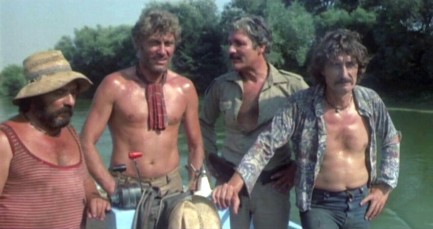  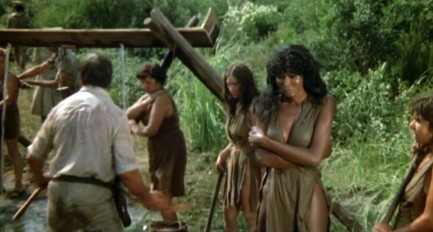   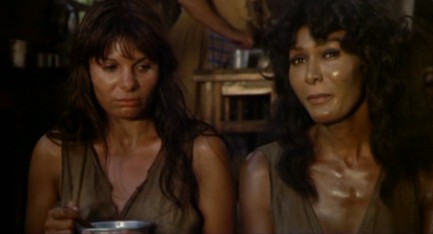 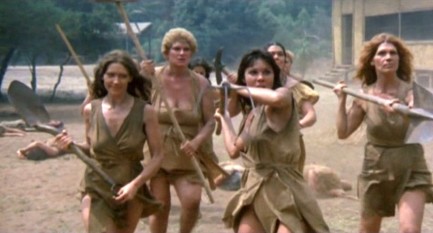   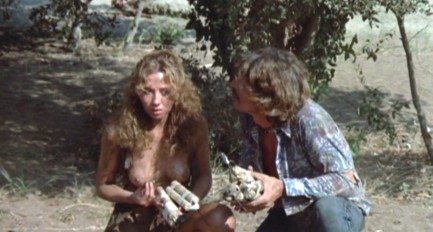

|
 |

The headlines that mattered yesteryear.
2003—Hope Dies
Film legend Bob Hope dies of pneumonia two months after celebrating his 100th birthday. 1945—Churchill Given the Sack
In spite of admiring Winston Churchill as a great wartime leader, Britons elect
Clement Attlee the nation's new prime minister in a sweeping victory for the Labour Party over the Conservatives. 1952—Evita Peron Dies
Eva Duarte de Peron, aka Evita, wife of the president of the Argentine Republic, dies from cancer at age 33. Evita had brought the working classes into a position of political power never witnessed before, but was hated by the nation's powerful military class. She is lain to rest in Milan, Italy in a secret grave under a nun's name, but is eventually returned to Argentina for reburial beside her husband in 1974. 1943—Mussolini Calls It Quits
Italian dictator Benito Mussolini steps down as head of the armed forces and the government. It soon becomes clear that Il Duce did not relinquish power voluntarily, but was forced to resign after former Fascist colleagues turned against him. He is later installed by Germany as leader of the Italian Social Republic in the north of the country, but is killed by partisans in 1945.
|

|
|

It's easy. We have an uploader that makes it a snap. Use it to submit your art, text, header, and subhead. Your post can be funny, serious, or anything in between, as long as it's vintage pulp. You'll get a byline and experience the fleeting pride of free authorship. We'll edit your post for typos, but the rest is up to you. Click here to give us your best shot.

|
|

















































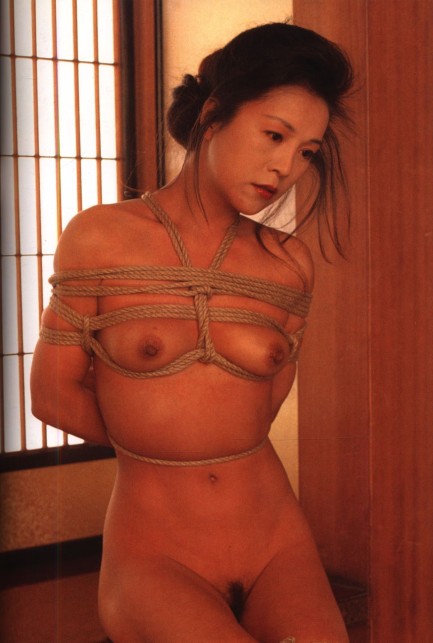













 as prisoners in order to aid the infiltration of the camp. Behind bars is one inmate—Wilson—who has the shining or something, and keeps telling the others that violence, death, and freedom are coming. Also coming are WIP staples such as the evil wardenness, languorous shower scenes, whippings, baroque tortures, and sexual assault. It all ends pro forma with a climactic shootout.
as prisoners in order to aid the infiltration of the camp. Behind bars is one inmate—Wilson—who has the shining or something, and keeps telling the others that violence, death, and freedom are coming. Also coming are WIP staples such as the evil wardenness, languorous shower scenes, whippings, baroque tortures, and sexual assault. It all ends pro forma with a climactic shootout.














































































